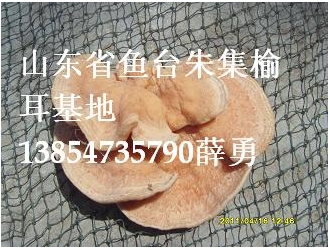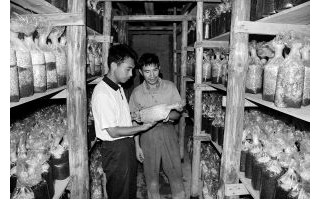松口蘑复合种形态学及生物地理学研究
MORPHOLOGICAL AND BIOGEOGRAPHIC STUDY ON TRICHOLOMA MATSUTAKE-COMPLEX
曹哲明 姚一建
摘 要:松口蘑复合种含有松口蘑Tricholoma matsutake (也称松茸)、北欧口蘑T. nauseosum、喜栎口蘑T. zangii和美洲口蘑T. magnivelare等4个分类单元.在对来自中国、日本、法国、西班牙、瑞典、芬兰和美国的标本进行形态学研究的基础上,认为松口蘑、北欧口蘑、喜栎口蘑形态十分接近,它们的分类地位应该重新考虑.美洲口蘑和它们的差别也不大.对松口蘑复合种的寄主和地理分布也进行了总结,发现松口蘑和美洲口蘑的寄主范围较广,寄主专化性不强,而北欧口蘑和喜栎口蘑的寄主比较专一.在地理分布上,松口蘑和美洲口蘑形成亚洲-北美地理替代种的分布格局;松口蘑和北欧口蘑形成欧亚间断分布的分布格局;喜栎口蘑的地理分布范围完全包含在松口蘑的分布范围中.松口蘑复合种种类的分布区和它们各自寄主的分布不一定完全相同.在松口蘑复合种内,北欧口蘑和松口蘑已被认为是同一个种,而其余两个分类单元的分类地位值得进一步研究.
关键词:松茸群,形态学特征,地理分布,分类学地位,寄主
分类号:Q939.5 文献标识码:A
文章编号:1672-6472(2004)01-0043-0055
基金项目:国家自然科学基金委员会"国家杰出青年基金"(30025002)、国家科学技术部国际科技合作重点项目计划(2001CB711103)、中国科学院"创新工程重要方向项目"(KSCX2-SW-101C)和"引进国外杰出人才"项目
作者简介:姚一建,通讯作者 Author for correspondence, E-mail:yaoyj@sun.im.ac.cn
作者单位:曹哲明(中国科学院微生物研究所真菌地衣系统学重点研究实验室,北京,100080)
姚一建(中国科学院微生物研究所真菌地衣系统学重点研究实验室,北京,100080)
参考文献:
[1]Arora D, 1986. Mushroom Demystified: a Comprehensive Guide to the Fleshy Fungi. Berkeley, CA: Ten Speed Press. 1~959
[2]Bergius N, Danell E, 2000. The Swedish matsutake (Tricholoma nauseosun syn. T. matsutake): distribution, abundance and ecology. Scandinavian Journal of Forest Research, 15: 18~325
[3]Bon M, 1976. Tricholomes de France et d'Europe occidentale. Documents Mycologiques, 6: 165~304
[4]Bon M, 1990. Combinaisons nouvelles et validations. Documents Mycologiques, 20 (79): 37~38
[5]Bu N, Jiang X L, 1996. Wild edible fungi in Mountain Gaoer. Edible Fungi of China, 15(2): 22~24 (in Chinese)
[6]Cao J Z, Zhu M, Liu B, 1991. Tricholoma matsutake is reported in Shanxi Province. Edible Fungi, 1991(4): 4 (in Chinese)
[7]Cao Z M, Yao Y J, Pegler D N, 2003. Tricholoma zangii, a new name for T. quercicola M. Zang. Mycotaxon, 85:159-164
[8]Chao Y, Liao GY, 1992. Wild edible fungi in District Panxi. Edible Fungi, 14(5): 5 (in Chinese)
[9]Chen H B, Zheng Y J, Li F Z, 1990. Flora of Shandong. Vol. 1. Qingdao: Qingdao Publishing House. 1~1518
[10]Dallmore W, Jackson A B, 1966. A handbook of Coniferae and Ginlgoaceae. 4th. Edition. London: Edward Arnold LTD. 1~729
[11]Delgersang, 1983. Tricholoma matsutake and its related species in Daxinganling Mountain. Edible Fungi, 1983(4): 3 (in Chinese)
[12]Fu L G, Chen T Q, Lang K Y, Hong T, 2000. High Plants of China. Vol. 3. Qingdao: Qingdao Publishing House. 1~757
[13]Fu W J, Xu G B, Liu J S, Lian Y J, 1996. Research on Distribution and Ecologial Environment of Tricholoma matsutake in Changbai Mountain Area. Acta Edulis Fungi, 3(3): 46~50 (in Chinese )
[14]Garcia J, Pedraza D, Silva I, Andrade L, Castillo J, 1998. Hongos Del Estado De Queretaro. Santiago de Queretaro: Red Regional En Recursos Bióicos Fomes 96: 1~263
[15]Guo W H, Xu N, 1992. An investigation on wild edible fungi in Milin of Tibet. Edible Fungi, 14(1): 5 (in Chinese)
[16]Hamada M, 1953. Matsutake. Shizen, 8 (10): 56~64
[17]Hosford D, Pilz D, Molina R Amaranthus M, 1997. Ecology and Management of the Commercially Harvested American Matsutake Mushroom. General Technical Report PNW-GTR-412. Portland, OR: U.S. Department of Agriculture, Forest Service, Pacific Northwest Research Station. 1~68
[18]Hu L C, Zeng L, Ren P, Li Z X, 1992. A preliminary investigation on wild edible fungi in Wan County. Edible Fungi of China, 11(4): 33~34 (in Chinese )
[19]Iwase K, 1992. Gluconic acid synthesis by the ectomycorrhizal fungus Tricholoma robustum. Canadian Journal of Botany, 70: 84~88
[20]Jing Y B, Ouyang N, 1985. Resource of edible fungi in Shengnongjia. Edible Fungi, 1985(4): 5~6 (in Chinese)
[21]Kinugawa K, Goto T, 1978. Preliminary survey on the " Matsutake "(Armillaria ponderosa) of North America. Transactions of the Mycological Society of Japan, 19: 91-101
[22]Kummel B, 1961. History of the Earth an introduction to Historical Geology, San Franciso and London: W. H. Freeman and Company. 1-610
[23]Kytovuori I, 1989. The Tricholoma caligatum group in Europe and North Africa. Karstenia, 28: 63~77
[24]Lian J W, 1994. Edible fungi of Mountain Daxinganling in Nei Mongol. Edible Fungi of China, 13(5): 19~20 (in Chinese )
[25]Liao S Y, Leng H Q, Liu B, 1989. Ecological study on Sichuan matsutake. Edible Fungi of China, 1989(3): 22~34 (in Chinese )
[26]Liao Z Y, Du M L, Ji D X, 2000. A preliminary investigation on wild edible fungi in District Maerkang, Edible Fungi, 22(7): 6 (in Chinese)
[27]Liu Z N, 1985. A preliminary investigation on economic macrofungi of Yunnan, Edible Fungi, 1985(5): 4~6 (in Chinese)
[28]Mao X L, 1998. Economic fungi of China. Beijing: Science Press. 1~762 (in Chinese)
[29]Mao X L, 2000. The macrofungi in China. Zhengzhou: Henan Science and Technology Press. 1~719 (in Chinese)
[30]Mao X L, Jiang C P, Ourencizhu, 1993. Economic Macrofungi of Tibet. Beijing: Beijing Science & Technology Press. 1~651 (in Chinese)
[31]Mao XL, Zhuang JY, 1997. Fungi of the Qinling Mounyains. Beijing: Chinese Agriculture Press. 1~181 (in Chinese )
[32]McIlvaine C, Macadam R K, 1912. One thousand American fungi (latest revised edition). Chicago: The Bobbs-Merrill Copmany Publishers. 1~749
[33]Mirov M, 1967. The genus Pinus. New York: Ronald Press. 1~602
[34]Ogawa M, 1976a. Microbial ecology of "shiro" in Tricholoma matsutake (Ito et Imai) Sing. and its allied species. Ⅲ Tricholoma matsutake in Pinus pumila var. yezoalpina forests. Transactions of the Mycological Society of Japan, 17: 176~187
[35]Ogawa M, 1976b. Microbial ecology of "shiro" in Tricholoma matsutake (Ito. et Imai) Sing. and its allied species. Ⅳ Tricholoma matsutake in Picea glehnii and Picea glehnii-Abies sachalinensis forests. Transactions of the Mycological Society of Japan, 17: 188~196
[36]Ogawa M, 1977a. Microbial ecology of "shiro" in Tricholoma matsutake (Ito. et Imai) Sing. and its allied species. Ⅳ Tricholoma matsutake in Tsuga diversifolia forests. Transactions of the Mycological Society of Japan, 18: 20~33
[37]Ogawa M, 1977b. Microbial ecology of "shiro" in Tricholoma matsutake (Ito. et Imai) Sing. and its allied species. Ⅴ Tricholoma matsutake in Tsuga sieboldii forests. Transactions of the Mycological Society of Japan, 18: 34~46
[38]Pan X R, 1993. Resource of medical fungi in forest area of Heilongjiang. Edible Fungi of China, 12(4): 25~27 (in Chinese )
[39]Qing S Y, Li W H, 1990. A preliminary investigation on the original plants of the commercial Tricholoma matsutake in Sichuan. Edible Fungi of China, 10(5): 25~26 (in Chinese )
[40]Redhead S A, 1984. Mycological observations 13-14: on Hypsizygus and Tricholoma. Transactions of the Mycological Society of Japan, 25: 1~9
[41]Redhead S A, 1989. A biogeographical overview of the Canadian mushroom flora. Canadian Journal of Botany, 67: 3003~3062
[42]Ryman S, Bergius N, Danell E, 2000. Proposal to conserve the name Armillaria matsutake against Armillaria nauseosa (Fungi. Basidiomycotia, Tricholomataceae). Taxon, 49: 555~556
[43]Smith A H, 1979. The stirps caligata of Armillaria in North America. Sydowia Annales Mycologici Beihft, 7: 368~377
[44]Sun F R, Zhang D M, Zhang S F, Li X G, Gao J J, 1997. A preliminary investigation on wild edible and medical fungi in Mountain J?lai. Edible Fungi of China, 16(3): 23~24 (in Chinese)
[45]Tai F L, 1979. Sylloge Fungorum Sinicum. Beijing : Science Press. 1~753 (in Chinese )
[46]Wang YZ, Zang M(eds.), 1983. Fungi of Tibet. Beijing: Science Press. 1~226 (in Chinese )
[47]Wang B, 1989. A preliminary investigation on ecology of Tricholoma matstuake in County Daocheng. Edible Fungi, 11(6): 4 (in Chinese)
[48]Wang B, 1995. A Comparative Study on Ecology and Nutritive Value of Tricholoma matsutake and T. quercicola. Acta Edulis Fungi, 2(1): 32~35 (in Chinese )
[49]Wang M F, 1989. An investigation on wild edible and medical fungi in District Liangshan. Edible Fungi, 11(6): 2~3 (in Chinese)
[50]Wang X R, Szmidt A E, 1993. Chloroplast DNA-based phylogeny of Asian Pinus species (Pinaceae). Plant Systematics and Evolution, 188: 197~211
[51]Wang Y, Hall I R, Evans L A, 1997. Ectomycorrhizal fungi with edible fruiting bodies 1. Tricholoma matsutake and related fungi. Economic Botany, 51: 311~327
[52]Wang Y, Xie Z X, 1982. Study on Tricholoma matstuake, Edible Fungi. 1982(1): 7~8 (in Chinese )
[53]Wei B G, Ling M L, 1985. Preliminary study on Guangxi matsutake, Edible Fungi, 1985(6): 1~2 (in Chinese)
[54]Xian M Y, 1987. Distribution and ecological condition of Tricholoma matstuake in Sichuan. Edible Fungi, 11(5): 9 (in Chinese)
[55]Yang S S, Li Z C, Li Y F, Wang Y, 1992. Edible fungiof Mountain Guancen in Province Shanxi. Edible Fungi, 14(3):4 (in Chinese)
[56]Ying J Z, Zang M, 1994. Economic Macrofungi in The Southwest of China. Beijing: Science Press. 218~220 (in Chinese )
[57]Yu Z X, 1987. An investigation on resource of wild edible fungi in Mountain Shishan of County Wuding. Edible Fungi, 1987(3): 4 (in Chinese)
[58]Yuan M S, Sun P Q. 1995. Sichuan Mushroom. Chengdu: Sichuan Science & technology Press. 1~737 (in Chinese )
[59]Zang M, 1990. A taxonomic and geographic study on the songrong (matsutake) group and its allied species. Act. Mycol. Sinica, 9(2): 113~127 (in Chinese )
[60]Zeller S M, Togashi K, 1934. The America and Japanese Matsutake. Mycologia, 26: 544~558
[61]Zhang Z F, Cheng YX, 1983. Preliminary survey on Yunnan matsutake. Edible Fungi, 1983(1): 4~5 (in Chinese)
[62]Zheng W J, Fu L G, 1978. Flora Reipublicae Popularis Sinicae. Vol. 7. Beijing: Science Press. 1~542
[63]Zhou Z K, 1992. Origination, evolution, and dispersal of Quercus of China. Acta Botanica Yunnanica, 14(3): 227~236
[64]Zhou Z K, 1999. Fossils of the fagaceae and their implications in systematics and biogeography. Acta Phytotaxonomica Sinica, 37(4): 369~385
[65]Zhu M, Cao J Z, Shi A R, Wang Q, 1992. Macrofungi of Mountain Guancen in Shanxi Province. Edible Fungi of China, 11(1): 22~23 (in Chinese )
[66]Проф E B, (translated by Zhong C X, Lu A D, Shen Z A, Hong B G, Wu Y S, Yao Z H, Zhou H B),1964. ИСТОРИЧЕСКАЯГЕОГРАФИЯРАСТЕНИЙ. Beijing: Science Press. 1~632







